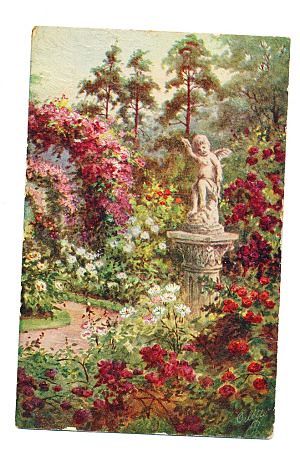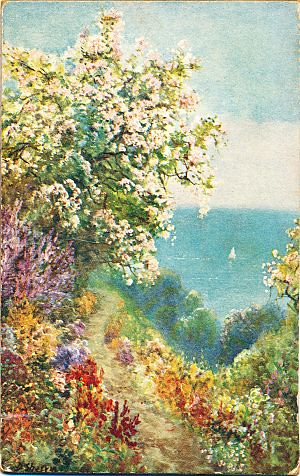John William Thompson and his wife Annie Newnham, (my great grandparents), had established a small, single room drapers shop in the village and for a few years they had prospered moving to a bigger shop at the centre of the village only just before the recession hit and the mine closed. Forced to sell out to their largest creditor, John had to resort to selling door to door from a suitcase. They were better off than many in the village but it must still have been a harsh come down for them in their early fifties.
 During this period, the family regularly received post cards from Annie's rather enigmatic elder sister Lillian. Not any old post cards, but gorgeous paintings of romantic gardens awash with light. The contrast with the reality of Esh Winning and the dark spirit of those depression years could not have been more jarring, but at the time beautiful little cards like these were winging their way daily all the way round the world.
During this period, the family regularly received post cards from Annie's rather enigmatic elder sister Lillian. Not any old post cards, but gorgeous paintings of romantic gardens awash with light. The contrast with the reality of Esh Winning and the dark spirit of those depression years could not have been more jarring, but at the time beautiful little cards like these were winging their way daily all the way round the world.The post-cards were "Oilettes" produced by the famous Raphael Tuck card manufacturers. Raphael Tuck was a deeply religious Jewish migrant to London from Prussia in the mid 19th Century. In 1866 he established a small shop in London selling printed cards including for the first time religiously themed Christmas cards.
 The shop made printed pictures accessible to the working classes en masse for the first time and the business grew like wild fire. By the 1880s, there were offices in Paris and New York and by 1900, in South America, India and South Africa. The strength of Raphael Tuck's influence was such that in 1898 the business was able to negotiate with the Post Master General for the introduction of the post card as we know it today with a full picture on one side and the message and address on the other.
The shop made printed pictures accessible to the working classes en masse for the first time and the business grew like wild fire. By the 1880s, there were offices in Paris and New York and by 1900, in South America, India and South Africa. The strength of Raphael Tuck's influence was such that in 1898 the business was able to negotiate with the Post Master General for the introduction of the post card as we know it today with a full picture on one side and the message and address on the other.There were some who sneered at the images and reproductions that Tuck sold but as the President of the Royal Academy himself said "Mr Tuck's graphic productions were likely more effective than all of the art galleries in the world" in introducing art to the public at large. They also allowed many working class families - even at the darkest times - to bring a little light into their lives.
If you enjoyed this little piece of my family's history please do follow me on Twitter and Pinterest.
No comments:
Post a Comment